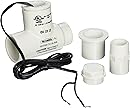KineticoUser
Member
- Messages
- 187
- Reaction score
- 3
- Points
- 18
My tenants called me and said the popcorn ceiling was falling down. I checked it out and discovered what appears to be a condensate line leak. It is somewhere in the wall between the floor of the attic and the ceiling of the first floor on a 2-story house. The line is a continuous 3/4" black polybutylene pipe that comes down through the wall and exits out the garage. I disconnected the line on top and blew through it to make sure there were no obstructions, and I felt no resistance. Water comes out of the line in the garage, but the tray is dry, and I encountered no water when I disconnected the line to check for obstructions. Part of that line that leaked in the past, but I could prove it was cut when I had a whole-house copper repipe. They fixed that, but I don't see how I can prove this leak was caused by the repipe plumbers. I figure the most cost effective way to fix this is to replace the vertical pipe run. Unfortunately, there is very little space in the attic (due to large HVAC ducting) and the downstairs ceiling (which also has a large HVAC duct running under the condensate pipe). The condensate pipe comes down the wall with the two freon lines to and from the compressor. The copper repipe was done about 8 years ago, and this is the first time this pipe has leaked.
The pipe is bent 90° above and below the wall. The other repair was done on the horizontal run in the ceiling of the first floor, and I can connect the new line to the old repair. How do you recommend I replace this line? Recommended materials and fittings would be appreciated, along with the easiest way to snake the new line up from the first floor. There is only about 3' space between the attic floor and the roof. There is a side-flow FAU in the attic, and the condensate line comes from a tray (about 30" X 36") mounted below that. Any suggestions would be appreciated.
The pipe is bent 90° above and below the wall. The other repair was done on the horizontal run in the ceiling of the first floor, and I can connect the new line to the old repair. How do you recommend I replace this line? Recommended materials and fittings would be appreciated, along with the easiest way to snake the new line up from the first floor. There is only about 3' space between the attic floor and the roof. There is a side-flow FAU in the attic, and the condensate line comes from a tray (about 30" X 36") mounted below that. Any suggestions would be appreciated.


